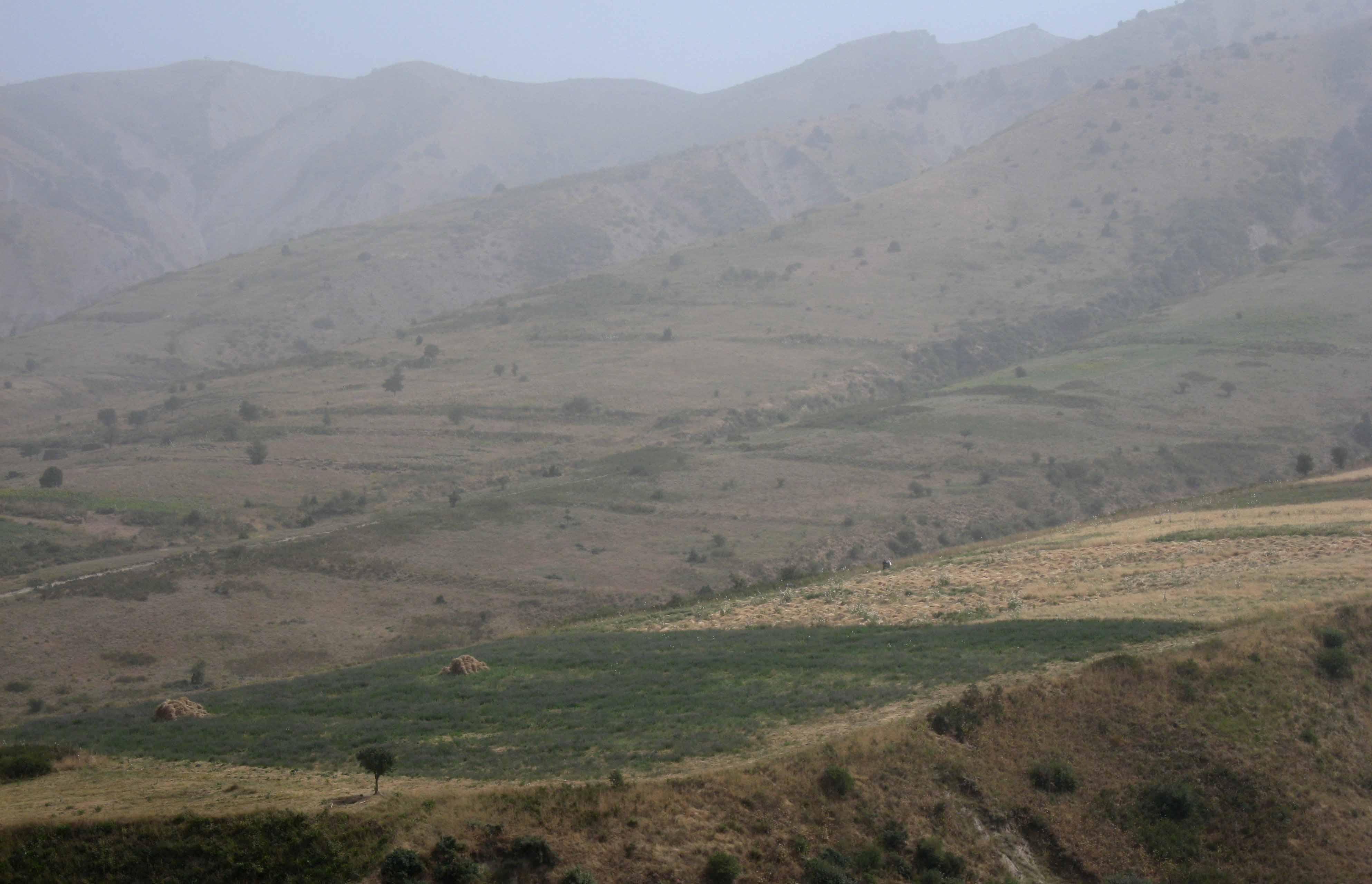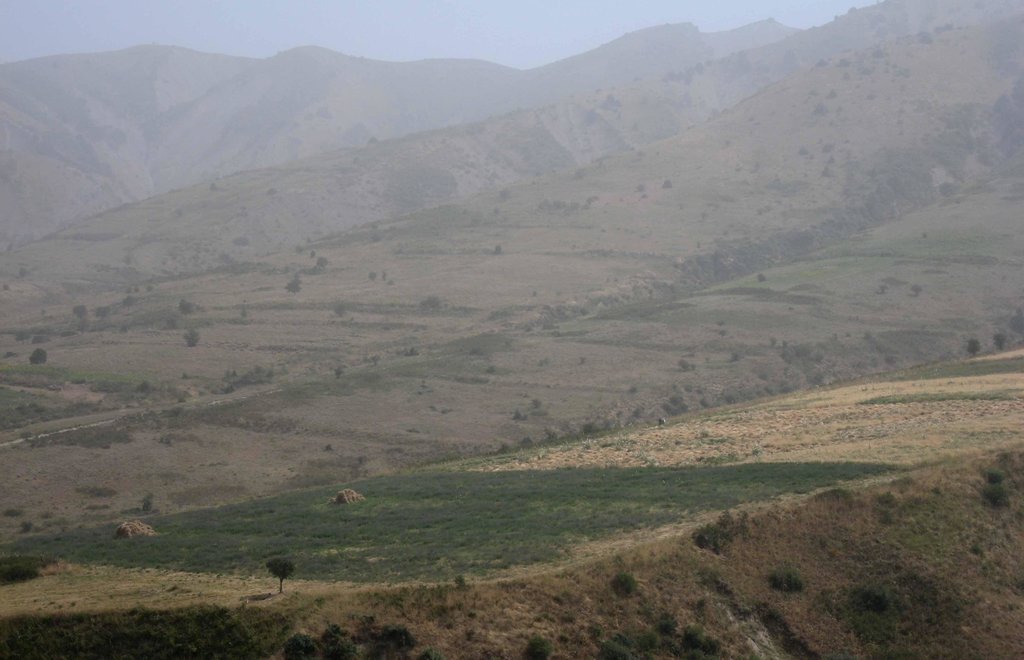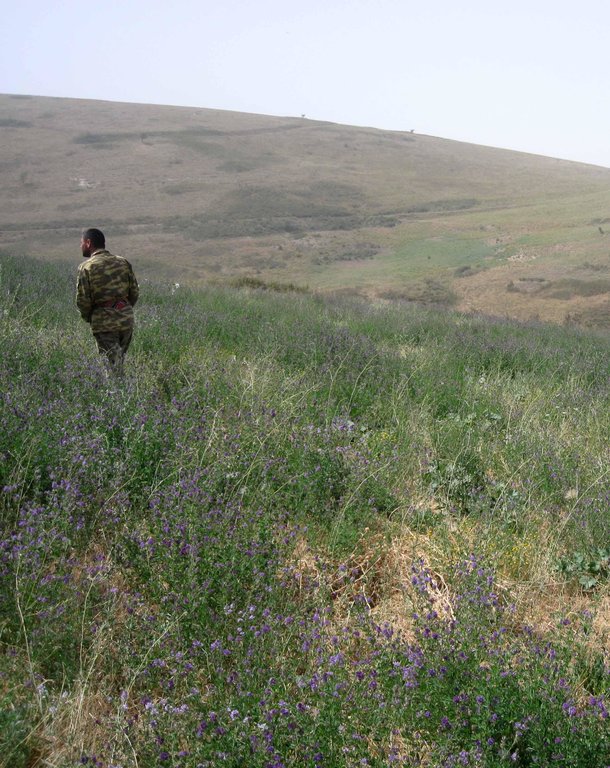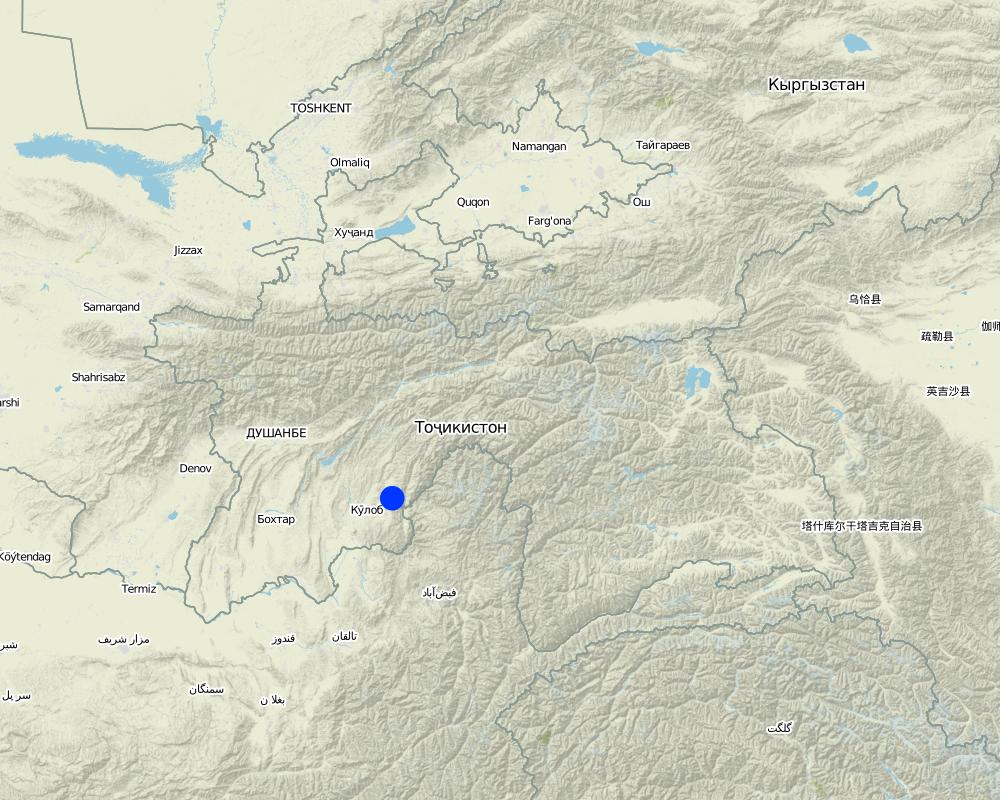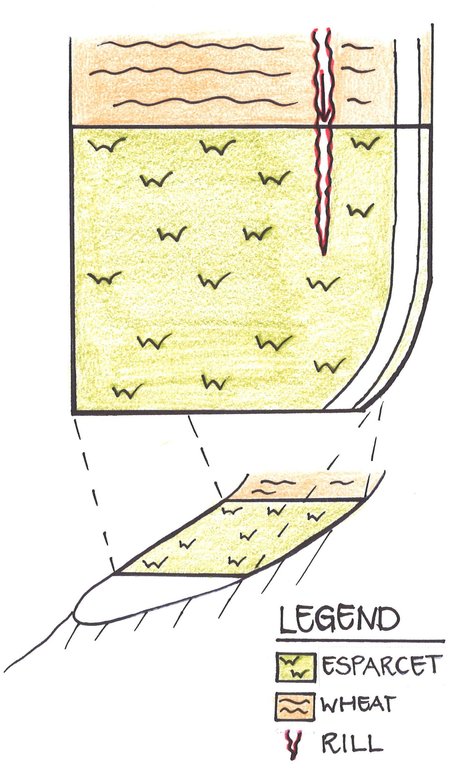Crop rotation including annual crops and Esparcet cultivation [Tajikistan]
- Creation:
- Update:
- Compiler: Malgorzata Conder
- Editor: –
- Reviewers: David Streiff, Alexandra Gavilano
technologies_1150 - Tajikistan
View sections
Expand all Collapse all1. General information
1.2 Contact details of resource persons and institutions involved in the assessment and documentation of the Technology
SLM specialist:
Name of the institution(s) which facilitated the documentation/ evaluation of the Technology (if relevant)
CARITAS (Switzerland) - SwitzerlandName of the institution(s) which facilitated the documentation/ evaluation of the Technology (if relevant)
CDE Centre for Development and Environment (CDE Centre for Development and Environment) - Switzerland1.3 Conditions regarding the use of data documented through WOCAT
The compiler and key resource person(s) accept the conditions regarding the use of data documented through WOCAT:
Yes
2. Description of the SLM Technology
2.1 Short description of the Technology
Definition of the Technology:
Crop rotation with current Esparcet production
2.2 Detailed description of the Technology
Description:
An Esparcet plot of one hectare is located on a hillslope in the Chukurak watershed. The owner lives in the valley far away from the plot. During the harvest, he is staying in the hills a whole week, because a daily journey to his house would take too much time. For the last three years, the farmer is cultivating Esparcet with the main aim to feed his cows. In two years, he will switch to a wheat or chickpea plot. In total, the farmer owns19 hectares of cropland, out of which the Esparcet plot accounts for 20% of his income. Next to the Esparcet plot, other farmers cultivate wheat and chickpea. In contrast to Esparcet, those plots must be protected from boars. Even though irrigation is impossible and the water point is situated far away, Esparcet grows very well because of the straight and spread-out roots. Esparcet is beneficial for the state of soil fertility and soil stabilization. Their seeds are more expensive than wheat seeds, but also result in a higher harvest. Esparcet can be harvested up to three times a year depending on water availability.
Purpose of the Technology: The main purpose of Esparcet cultivation is fodder production for the cows. The farmer owns other plots where he cultivates wheat. Moreover, it’s a good location for an Esparcet plot: Even though water is not available Esparcet maintains the soil moisture and nutrients while reducing soil erosion. Thanks to the crop rotation, the soil is in a healthy state. Yield quantity and quality are very satisfying for the farmer.
Establishment / maintenance activities and inputs: The farmer stresses that good knowledge is needed to know where, what and how to cultivate. He learned from other farmers. Before establishing the perennial crop, he first planted a nurse crop of fodder grain in spring. Nurse crops strengthen soil stability while minimizing weed and overly sunlight. Plowing, sowing and cutting are initial as well as recurrent activities. No fertilizer and no plot guarding are needed. Initial costs when growing Esparcet are higher than for wheat, because Esparcet seeds are more expensive. Additionally, seeds of the nurse crop are needed.
Not to neglect is the long way from the farmers’ house to the plot which takes time and fuel, but the farmers of that hillslope often give a lift to each other. Also during harvest the neighboring farmers are helping out.
Natural / human environment: The plot on the hillslope is located far away from the farmer’s’ village Sarmaydon 2. It’s situated at around 2000m asl below the hill peaks, where boars are entering. On three sides, the plot is delimited naturally by incised riverbeds which make accessibility more difficult. Due to the high altitude, there are low temperatures and high moisture. Above the Esparcet cultivation, wheat and chickpea plots are cultivated leading to off-site effects on the Esparcet plot. In the Esparcet plot, a deep rill developed originating from the wheat plot situated upslope.
2.3 Photos of the Technology
2.5 Country/ region/ locations where the Technology has been applied and which are covered by this assessment
Country:
Tajikistan
Region/ State/ Province:
Khatlon, Tajikistan
Further specification of location:
Muminabad
Specify the spread of the Technology:
- evenly spread over an area
If precise area is not known, indicate approximate area covered:
- < 0.1 km2 (10 ha)
Comments:
Total area covered by the SLM Technology is 0.01 km2.
Map
×2.6 Date of implementation
If precise year is not known, indicate approximate date:
- less than 10 years ago (recently)
2.7 Introduction of the Technology
Specify how the Technology was introduced:
- through land users' innovation
3. Classification of the SLM Technology
3.1 Main purpose(s) of the Technology
- improve production
3.2 Current land use type(s) where the Technology is applied

Cropland
- Annual cropping
Annual cropping - Specify crops:
- cereals - wheat (spring)
- cereals - wheat (winter)
- Lucerne, Esparcet, Chickpea
Number of growing seasons per year:
- 1
Specify:
Longest growing period in days: 160Longest growing period from month to month: April-Sept

Grazing land
Comments:
Major land use problems (compiler’s opinion): The Esparcet plot is quite beneficial for soil and water properties. It is hence a good initial cultivation for future crop types. Soil stability is crucial as the plot is delimited by a riverbed on both sides. A wheat plot is located just above the Esparcet production. A rill developed in the upper plot, so that off-site effects like rill formation and sediment deposition are affecting the Esparcet plot.
Major land use problems (land users’ perception): Esparcet is maintaining soil stability and moisture which prevents major degradation. Several km2 got affected by washed soil form the upper part. No irrigation is possible.
3.4 Water supply
Water supply for the land on which the Technology is applied:
- rainfed
3.5 SLM group to which the Technology belongs
- pastoralism and grazing land management
- improved plant varieties/ animal breeds
3.6 SLM measures comprising the Technology

agronomic measures
- A1: Vegetation/ soil cover
- A2: Organic matter/ soil fertility
Comments:
Main measures: agronomic measures
Type of agronomic measures: rotations / fallows
3.7 Main types of land degradation addressed by the Technology

soil erosion by water
- Wt: loss of topsoil/ surface erosion
- Wg: gully erosion/ gullying
- Wo: offsite degradation effects

chemical soil deterioration
- Cn: fertility decline and reduced organic matter content (not caused by erosion)

physical soil deterioration
- Pc: compaction
Comments:
Main type of degradation addressed: Wt: loss of topsoil / surface erosion, Wo: offsite degradation effects
Secondary types of degradation addressed: Wg: gully erosion / gullying, Cn: fertility decline and reduced organic matter content, Pc: compaction
Main causes of degradation: crop management (annual, perennial, tree/shrub), inputs and infrastructure: (roads, markets, distribution of water points, other, …) (Bad accessibility to settlement, market etc. Water point is far away)
Secondary causes of degradation: soil management
3.8 Prevention, reduction, or restoration of land degradation
Specify the goal of the Technology with regard to land degradation:
- prevent land degradation
Comments:
Main goals: prevention of land degradation
4. Technical specifications, implementation activities, inputs, and costs
4.1 Technical drawing of the Technology
Technical specifications (related to technical drawing):
The Esparcet plot is located on a hillslope and is laterally delimited by embankments. The density of the vegetation cover varies within the plot. A rill building was observed in the upper part of the plot, originating in the wheat cultivation with very low vegetation cover located upslope.
Location: Chukurak watershed. Muminabad, Khatlon, Tajikistan
Date: 14.02.2013
Technical knowledge required for field staff / advisors: low (Basic agricultural knowledge is required. If technical knowledge about cultivation is available Esparcet cropping is not especially challenging. Nurse crop may be possibly applied.)
Technical knowledge required for land users: low
Main technical functions: control of concentrated runoff: retain / trap, control of concentrated runoff: impede / retard, control of concentrated runoff: drain / divert, improvement of ground cover, improvement of topsoil structure (compaction), stabilisation of soil (eg by tree roots against land slides), increase / maintain water stored in soil
Secondary technical functions: increase of surface roughness, improvement of surface structure (crusting, sealing), improvement of subsoil structure (hardpan), increase in organic matter, increase in nutrient availability (supply, recycling,…), increase of infiltration, sediment retention / trapping, sediment harvesting
Rotations / fallows
Material/ species: Esparcet
Quantity/ density: 3.75t/ha
Remarks: with fodder grain as nurse crop
Author:
Malgorzata Conder
4.2 General information regarding the calculation of inputs and costs
Specify currency used for cost calculations:
- USD
Indicate average wage cost of hired labour per day:
12.40
4.3 Establishment activities
| Activity | Timing (season) | |
|---|---|---|
| 1. | Plowing- lab. light: 1.5 hours, 1 person | |
| 2. | Plowing - tractor rent | |
| 3. | Plowing - petrol | |
| 4. | Fodder grain seeds | |
| 5. | Esparcet seeds | |
| 6. | Sowing Grain and Esparcet - lab.light: 1.5 hours, 1 person |
4.4 Costs and inputs needed for establishment
| Specify input | Unit | Quantity | Costs per Unit | Total costs per input | % of costs borne by land users | |
|---|---|---|---|---|---|---|
| Labour | Plowing | Person/day | 0.2 | 15.5 | 3.1 | 100.0 |
| Labour | Sowing | Esparcet seeds | 0.2 | 15.5 | 3.1 | 100.0 |
| Equipment | Tractor rent | hours | 3.0 | 6.9 | 20.7 | 100.0 |
| Equipment | Petrol for plowing | litres | 40.0 | 1.14 | 45.6 | 100.0 |
| Plant material | Fodder Grain seeds | kg | 70.0 | 0.414285 | 29.0 | 100.0 |
| Plant material | Esparcet seeds | kg | 20.0 | 6.21 | 124.2 | 100.0 |
| Total costs for establishment of the Technology | 225.7 | |||||
| Total costs for establishment of the Technology in USD | 225.7 | |||||
Comments:
Duration of establishment phase: 0.033 month(s)
4.5 Maintenance/ recurrent activities
| Activity | Timing/ frequency | |
|---|---|---|
| 1. | Cutting Esparcet | 2 times a year (1. cut and 2. cut) |
4.6 Costs and inputs needed for maintenance/ recurrent activities (per year)
| Specify input | Unit | Quantity | Costs per Unit | Total costs per input | % of costs borne by land users | |
|---|---|---|---|---|---|---|
| Labour | Cutting Esparcet | Person/day | 94.5 | 12.43 | 1174.63 | 100.0 |
| Labour | machine use to cut | hours | 2.0 | 31.1 | 62.2 | 100.0 |
| Equipment | Petrol | litres | 40.0 | 1.14 | 45.6 | 100.0 |
| Total costs for maintenance of the Technology | 1282.43 | |||||
| Total costs for maintenance of the Technology in USD | 1282.43 | |||||
Comments:
Second labor input for harvesting Esparcet was calculated proportionally to the yield: 100% first harvest and 50% for second harvest.
4.7 Most important factors affecting the costs
Describe the most determinate factors affecting the costs:
The most determinate factor is theoretically the cost to harvest the Esparcet. Labour input is not based on money, but on mutual support among the farmers. So the farmer will have to work on plots of other farmers to compensate the support he gets. Besides, seeds and tractor renting are the most expensive aspects of Esparcet cultivation.
5. Natural and human environment
5.1 Climate
Annual rainfall
- < 250 mm
- 251-500 mm
- 501-750 mm
- 751-1,000 mm
- 1,001-1,500 mm
- 1,501-2,000 mm
- 2,001-3,000 mm
- 3,001-4,000 mm
- > 4,000 mm
Specifications/ comments on rainfall:
Totally 800mm: 700mm in winter-spring, July-Sept dry season (At 1200m asl, weather Station Muminabad). Precipitation increases with the altitude: in average 60mm per 100m (in here approx.1300mm)
Agro-climatic zone
- sub-humid
Thermal climate class: temperate
LPG from April until September
5.2 Topography
Slopes on average:
- flat (0-2%)
- gentle (3-5%)
- moderate (6-10%)
- rolling (11-15%)
- hilly (16-30%)
- steep (31-60%)
- very steep (>60%)
Landforms:
- plateau/plains
- ridges
- mountain slopes
- hill slopes
- footslopes
- valley floors
Altitudinal zone:
- 0-100 m a.s.l.
- 101-500 m a.s.l.
- 501-1,000 m a.s.l.
- 1,001-1,500 m a.s.l.
- 1,501-2,000 m a.s.l.
- 2,001-2,500 m a.s.l.
- 2,501-3,000 m a.s.l.
- 3,001-4,000 m a.s.l.
- > 4,000 m a.s.l.
Comments and further specifications on topography:
Altitudinal zone is just around 2000m a.s.l. and might belong already to upper part of Watershed system
Slopes on average are 17-25%
5.3 Soils
Soil depth on average:
- very shallow (0-20 cm)
- shallow (21-50 cm)
- moderately deep (51-80 cm)
- deep (81-120 cm)
- very deep (> 120 cm)
Soil texture (topsoil):
- medium (loamy, silty)
- fine/ heavy (clay)
Topsoil organic matter:
- medium (1-3%)
If available, attach full soil description or specify the available information, e.g. soil type, soil PH/ acidity, Cation Exchange Capacity, nitrogen, salinity etc.
Soil fertility is medium
Soil drainage / infiltration is medium
Soil water storage capacity is high
5.4 Water availability and quality
Ground water table:
< 5 m
Availability of surface water:
medium
Water quality (untreated):
for agricultural use only (irrigation)
Comments and further specifications on water quality and quantity:
Availability of surface water (medium): Autumn - spring
Availability of surface water (poor/none): July - September
5.5 Biodiversity
Species diversity:
- medium
5.6 Characteristics of land users applying the Technology
Market orientation of production system:
- subsistence (self-supply)
- mixed (subsistence/ commercial)
Off-farm income:
- less than 10% of all income
Relative level of wealth:
- average
Individuals or groups:
- individual/ household
Level of mechanization:
- manual work
- mechanized/ motorized
Gender:
- men
Indicate other relevant characteristics of the land users:
Land users applying the Technology are mainly common / average land users
Population density: 100-200 persons/km2
Annual population growth: 1% - 2%
Off-farm income specification: 20% of income of the lucerne plot, rest from other cropland of totally 19 ha and 5 ha of pasture
Level of mechanization: Mechanized/motorized mostly for plowing and harvesting, whereby sowing is manual work.
5.7 Average area of land used by land users applying the Technology
- < 0.5 ha
- 0.5-1 ha
- 1-2 ha
- 2-5 ha
- 5-15 ha
- 15-50 ha
- 50-100 ha
- 100-500 ha
- 500-1,000 ha
- 1,000-10,000 ha
- > 10,000 ha
Is this considered small-, medium- or large-scale (referring to local context)?
- small-scale
Comments:
2.06 ha, if 7.7 pers/household
5.8 Land ownership, land use rights, and water use rights
Land ownership:
- state
Land use rights:
- leased
Water use rights:
- communal (organized)
Comments:
Land ownership is based on the land user certificate conferred by the government
5.9 Access to services and infrastructure
health:
- poor
- moderate
- good
education:
- poor
- moderate
- good
technical assistance:
- poor
- moderate
- good
employment (e.g. off-farm):
- poor
- moderate
- good
markets:
- poor
- moderate
- good
energy:
- poor
- moderate
- good
roads and transport:
- poor
- moderate
- good
drinking water and sanitation:
- poor
- moderate
- good
financial services:
- poor
- moderate
- good
6. Impacts and concluding statements
6.1 On-site impacts the Technology has shown
Socio-economic impacts
Production
crop production
Comments/ specify:
First year only one cut possible but after that yield increases to a positive extent
fodder production
fodder quality
animal production
risk of production failure
Income and costs
expenses on agricultural inputs
Comments/ specify:
Esparcet seeds are relatively expensive compared to other seed types
workload
Comments/ specify:
No guarding needed
Socio-cultural impacts
food security/ self-sufficiency
conflict mitigation
Livelihoods and human well-being
Ecological impacts
Water cycle/ runoff
surface runoff
groundwater table/ aquifer
evaporation
Soil
soil moisture
soil cover
soil loss
soil crusting/ sealing
soil compaction
nutrient cycling/ recharge
soil organic matter/ below ground C
Biodiversity: vegetation, animals
biomass/ above ground C
Other ecological impacts
Hazards towards adverse events
6.2 Off-site impacts the Technology has shown
downstream siltation
buffering/ filtering capacity
damage on neighbours' fields
6.3 Exposure and sensitivity of the Technology to gradual climate change and climate-related extremes/ disasters (as perceived by land users)
Gradual climate change
Gradual climate change
| Season | increase or decrease | How does the Technology cope with it? | |
|---|---|---|---|
| annual temperature | increase | well |
Climate-related extremes (disasters)
Meteorological disasters
| How does the Technology cope with it? | |
|---|---|
| local rainstorm | not well |
| local windstorm | not known |
Climatological disasters
| How does the Technology cope with it? | |
|---|---|
| drought | well |
Hydrological disasters
| How does the Technology cope with it? | |
|---|---|
| general (river) flood | not known |
Other climate-related consequences
Other climate-related consequences
| How does the Technology cope with it? | |
|---|---|
| reduced growing period | not known |
Comments:
High vegetation cover, improvement through more uniform sowing. Sowing manually causes an irregular soil cover and might be less tolerant to heavy rainfalls and drought.
6.4 Cost-benefit analysis
How do the benefits compare with the establishment costs (from land users’ perspective)?
Short-term returns:
positive
Long-term returns:
very positive
How do the benefits compare with the maintenance/ recurrent costs (from land users' perspective)?
Short-term returns:
very positive
Long-term returns:
very positive
Comments:
Yield is lower in the first year of the establishment but more cuts are possible in the next years. In the longer term, it is more beneficial for soil properties: Good soil nutrient and soil moisture availability, soil stabilization and reduced soil erosion and off-site effects.
6.5 Adoption of the Technology
- single cases/ experimental
If available, quantify (no. of households and/ or area covered):
1 Household
Of all those who have adopted the Technology, how many did so spontaneously, i.e. without receiving any material incentives/ payments?
- 91-100%
Comments:
1 land user families have adopted the Technology without any external material support
Comments on spontaneous adoption: There is no other perennial crop in the Chukurak watershed, but neighbors of the farmer with the Esparcet plot may change in future into Esparcet production for rotation.
There is no trend towards spontaneous adoption of the Technology
Comments on adoption trend: No adoption is done, but farmers might think about it.
6.7 Strengths/ advantages/ opportunities of the Technology
| Strengths/ advantages/ opportunities in the land user’s view |
|---|
| Good yield, if you sell it you can buy comparatively a good quantity of wheat |
| Guaranteed fodder availability for livestock |
| Strengths/ advantages/ opportunities in the compiler’s or other key resource person’s view |
|---|
| Several harvests per year (up to three harvests) possible especially in the hills where precipitation is high |
|
Esparcet has many beneficial on- and off-site effects concerning soil quality, reduced soil erosion etc. How can they be sustained / enhanced? Knowledge transfer to other farmers |
|
Moderate work load (no guarding of the plot from boar) How can they be sustained / enhanced? Promote perennial crops among local farmers |
6.8 Weaknesses/ disadvantages/ risks of the Technology and ways of overcoming them
| Weaknesses/ disadvantages/ risks in the land user’s view | How can they be overcome? |
|---|---|
| First year only one cut is possible, and thus the farmer has to accept a lower yield compared to the cultivation of wheat |
| Weaknesses/ disadvantages/ risks in the compiler’s or other key resource person’s view | How can they be overcome? |
|---|---|
| Farmers need to cultivate food crops. A small scale farmer would only produce Esparcet if he already has a wheat crop somewhere, even if the latter is less profitable | Knowledge transfer |
7. References and links
7.1 Methods/ sources of information
Links and modules
Expand all Collapse allLinks
No links
Modules
No modules


